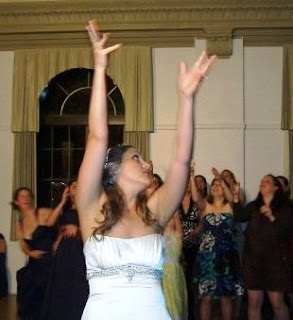Here are seven ways to avoid being disappointed with your Fort Wayne wedding reception entertainment. The points are very solid and as with any wedding decision on hiring any entertainer (DJ/disc jockey, MC/Master of Ceremonies, or band), much thought must go into place before you sign on the dotted line.
 |
| Always have a detailed contract for your wedding |
COMMON MISTAKE #1: CONTRACTING A DJ/DISC JOCKEY BASED ON PRICE ALONE.
This is a huge mistake to avoid when planning your dream wedding. The musical entertainment is one of the most important elements in the success (or failure) of the “party” portion of your wedding reception. Try to keep in mind the IMPORTANCE level of your wedding and how much you want your wedding to be an awesome event!
An exceptional wedding entertainer will work with you ahead of time so that all of the elements are seamless and polished. Your Fort Wayne DJ should satisfy you and your guests AND he/she should leave you with great memories of your wedding celebration. Base your decision to hire an individual or company on what features and services they offer you, not on price alone. The "best price" is not always the "best value." Just because someone has a business card with the words "Professional DJ" on it does not mean much. Would you choose a doctor for an important surgery based on which one is cheapest?
 |
| Ask your potential DJ a lot of pointed questions |
COMMON MISTAKE #2: WAITING TOO LONG TO HIRE THE ENTERTAINMENT.
Time is of the essence when locating and hiring your wedding entertainment. No one has unlimited resources. If your wedding reception is scheduled for April, May, June, July, August, September, October, or December, you need to book your entertainment (DJ or band) much earlier than the rest of the year. Entertainment for weddings, high school proms, homecomings, reunions, and holiday parties is much more in demand during these months. In addition, the best Fort Wayne entertainers usually get hired first which makes them unavailable for a given date much earlier than others.
COMMON MISTAKE#3: NOT DETERMINING THE EXPERIENCE LEVEL OF STAFF FOR YOUR WEDDING.
Determining the actual experience level of your entertainer is quite important for your wedding. Knowing this key piece of information will help you understand how well your wedding reception will be handled when unexpected problems arise as well as the overall atmosphere of your event. Look for an individual or company with at least five years in the wedding industry. Specifically ask if they have the type of experience that you expect for your wedding. 10 years of experience is recommended for most quality DJs in Indiana. Weddings are more detailed and complicated than a backyard party or high school dance. Making certain that your wedding DJ is proficient as an MC (master of ceremonies) is also important. MCs who can also officiate wedding ceremonies will naturally also perform better at the basics.
COMMON MISTAKE#4: NOT CHECKING ON BACKUP EQUIPMENT.
Backup equipment needs to be on-site, hooked up, and ready to go for each and every event - especially yours! Make certain that your event will not "end early" due to equipment failure with no way to get the show back up and running in under 5 minutes. Also, make sure that your entertainer will not back out of your engagement because of equipment failure. See (#5) below for more equipment information.
 |
| Back up equipment should be on site |
COMMON MISTAKE#5: SELECTING AN ENTERTAINER WHO DOES NOT USE PROFESSIONAL EQUIPMENT.
Professional grade equipment is a must for all events. An entertainer who uses home stereo or consumer grade equipment puts your party at risk of unexpected breakdowns - blown loudspeakers, amplifier shutdowns, and improperly operating equipment. Consumer grade equipment was never designed for heavy-duty use, constant transportation, and the other range of variables such as extreme temperature, humidity, and dust that it will inevitably be subjected to in our trade. Although professional equipment is not indestructible, it is designed to withstand this type of use as well as being designed for sound reinforcement applications.
COMMON MISTAKE#6: NOT CHECKING THE ENTERTAINER'S CREDENTIALS.
This is a HUGE mistake to avoid when planning your dream reception. Check your local Better Business Bureau concerning the individual or company you are considering. If the entertainer that you are considering has had complaints made against them to the BBB, you could be the next person who hires that entertainer and receives unsatisfactory service. Keep in mind that many "moon-lighters" are not even on file with the BBB, but still may do an "OK" job. However, if an entertainer that you are considering has NO file with the BBB AND no website, watch out! These charlatans do not take this business seriously and most times lack necessary experience, insurance requirements, business licenses or certificates of compliances, and/or other areas of concern (such as proper ethics). Another great source of reference is to check with the manager at the facility you are renting or other professionals such as photographers. Once again, just because a DJ calls their service "PROFESSIONAL" does not make it so.
 |
| Reception entertainment |
COMMON MISTAKE#7: BELIEVING THAT A PARTICULAR SETUP WILL BE THE SETUP AT YOUR WEDDING.
Most DJ's or companies use different equipment from the equipment you saw in their office, at a bridal show, or at a particular engagement. The sound setup at your wedding reception could be considerably different from how it looked before. Ask for pictures or video footage before hiring anyone. Your particular reception hall may be too small or too large for a given setup. If the setup is too small, find out if the entertainer offers larger equipment. Few companies offer standard equipment (this is where all the entertainers from a given company all use the same basic setup). Make certain that enough room is available at your reception hall for the setup; conversely, if the setup is quite small, it may be too small for your particular event.
 |
| Professional MCs and Officiants |
2010 and 2011 dates are filling up quickly, so contact Megasound at 260.484.2460 to secure your wedding reception date today!!






















































